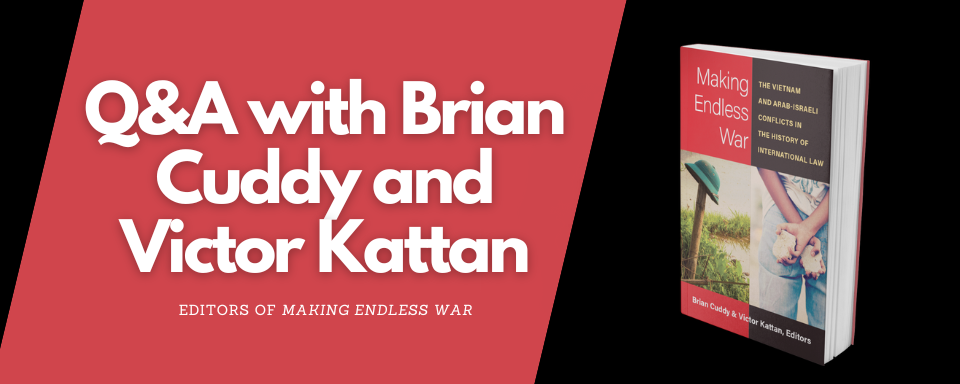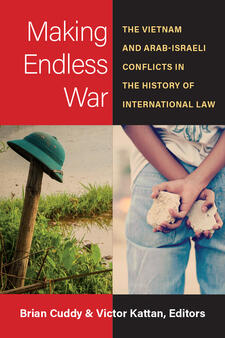Q&A with Brian Cuddy and Victor Kattan

This guest author post is a Q&A with Brian Cuddy and Victor Kattan, editors of Making Endless War: The Vietnam and Arab-Israeli Conflicts in the History of International Law, from the University of Michigan Press. The book is available in hardcover, paper, and open access.
What initially inspired you to focus on the Vietnam and Arab-Israeli conflicts?
We discovered similarities in each other’s work by chance. Victor was intrigued by something that Brian published in The New York Times on the legal arguments the United States used to justify its intervention in Cambodia during the Vietnam War. It occurred to Victor that Brian’s work on American legal arguments in the Vietnam War bore a striking resemblance to Israeli arguments in its conflicts with the Palestinians and the wider Arab world that he was working on. It was the parallels – in language, law, practices, personalities, and technologies – that drew our attention to these two conflict zones.
We first met in person at a conference organised by Professor Anne Orford at Melbourne Law School in May 2018. We discussed organizing a workshop that would examine the connections between these two conflicts. This was held in Singapore in December 2018 at the Middle East Institute, an autonomous research institute at the National University of Singapore.
What surprised you the most during your research for this book?
As editors of this volume we were really happy with how the different chapters came together to advance the overall themes of the book. We were not so much surprised by this—we knew what a wonderful group of chapter authors we had assembled!—as we were pleased that our original intuition on the value of considering the two conflicts together proved durable.
Across the volume’s chapters, our contributing authors show how the Vietnam and Middle East conflicts were central to debates over the meaning of “aggression,” “armed attack,” and “self-defense” in the legal prohibition on the use of force in international affairs, as well as debates over who could fight in wars and how they could fight. Our authors consider a range of actors who influenced not only prominent public lawmaking moments, but also the slower behind-the-scenes accretion of interpretation and practice. Whether looking at particular doctrinal questions or at the broader political purpose of international law, our contributing authors do a fine job of collectively advancing the argument that the Vietnam and Middle East conflicts were fundamental to the development of our current international legal order.
What impact have the Vietnam and Arab-Israeli conflicts had on international law?
In the book we argue that they have had a disproportionately large impact on the laws of war given that the Vietnam War is now history, and the Arab-Israeli conflicts could become history.
The way we measure impact is to look at qualitative and quantitative data. In the last chapter of the book titled “War and the Shaping of International Law: From the Cold War to the War on Terror” we show how the Vietnam War and the Arab-Israeli conflicts changed American society due to their length, their intensity, and the passions they provoked in the popular media, on university campuses, and on the street. The Vietnam War and the multiple Arab-Israeli conflicts became cultural moments that captured the public imagination in ways few other conflicts did, even those that were more lethal. They also had an oversized impact on public policy not only in North America, but also in Europe and Australia. They transformed the ways in which governments speak about war and how they justify them.
We assessed these changes not only through studies of popular media, film, and literature, as scholars like Amy Kaplan did, in Our American Israel: The Story of an Entangled Alliance (Harvard University Press, 2018), but also in the number of references to these two conflicts in policy statements, political speeches, government publications, political memoirs, and references to scholarly publications on the law of war that are covered in various chapters of the book. Some of the chapters in the book also cover the development of new branches of the law in the United States, such as “national security law” and “operational law” that owed their developments to the conflicts in Vietnam and the Middle East.
What do you think international law on the use of force may look like in the future?
The various contributors to the book hint at some developments– mostly ideological and technological – associated with attempts to change the law on the use of force. We don’t think these attempts or rationalizations for employing armed force in a variety of contexts have succeeded in changing the law. This is important to emphasise. Nonetheless, we think that these attempts are worth studying for what they tell us about efforts to change international law to further the foreign policy aims of particular interest groups, whether it be Vietnam War veterans or neoconservatives during the Cold War, or antiwar activists attempting to challenge imperial practices by setting up people’s tribunals. Rather than look just at how international law develops in formal interactions between states in multilateral settings, we also look at how interest groups attempt to influence foreign policy, within states, with a view to influencing the development of international law in a particular direction. It is too soon to say whether any of these attempts will succeed in actually changing international law on the use of force.
What do you hope readers will take away from reading Making Endless War?
We hope the volume will give readers a different framework for understanding the history of law and war since World War II. As we outline in the opening chapter, one of the more prominent stories currently told about international law in the twentieth century is the outlawing of aggressive war and territorial conquest. This was one of the central arguments advanced by Professors Oona Hathaway and Scott Shapiro in their book The Internationalists: How a Radical Plan to Outlaw War Remade the World (New York: Simon and Schuster, 2017). In this story, the rejection of war and conquest as lawful acts entailed a remarkable legal and political transformation: witness the sharp reduction in interstate armed conflict and territorial annexation after World War II. While acknowledging that war persisted after 1945, this story tends to view post-1945 armed conflicts as aberrations or side-shows with marginal relevance to the development of international law. Our volume begins from the opposite premise: that international law and arguments about international law have developed not in spite of post-1945 armed conflicts, but because of them. This approach allows us to move beyond explaining the end of war as a legal institution and towards understanding the attempted institutionalization of endless war.
Of the wars fought since 1945, we focus on two as particularly important in the making of endless war, the Vietnam and Middle East conflicts. These wars were not just physical confrontations. They were also battles of ideas, including legal ideas. The parties to these conflicts appealed widely to international laws and customs. These appeals rested not only on settled understandings of the relevant international law but also on legal interpretations that attempted to shift those understandings. We try to show that those novel legal interpretations did not always arise in each conflict independently, but were often the product of migrations and mutations of legal knowledge between the two war zones. It is in considering the Vietnam and Middle East conflicts in tandem, then, that allows for a fresh perspective on the history of international law since World War II.



